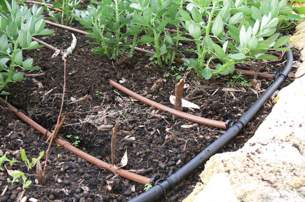Drip Irrigation: Water-Efficient Landscaping and Gardening

A healthy, living landscape full of a variety of beautiful plants not only adds your creative touch to your green home's outdoor living spaces, it provides habitat for birds, butterflies, and other animals. A home garden provides nutritious and delicious food for you and your family. Keeping your outdoor spaces healthy can unfortunately take quite a bit of watering, which any green homeowner should seek to minimize. One way to cut down on watering is to use drip irrigation.
Drip Irrigation for Maximum Water Efficiency
Drip irrigation is the most efficient form of watering outdoor spaces. Conventional irrigation systems (sprinklers) are around 75 to 85% efficient, meaning about 20% of your precious water never reaches the plants' roots where its needed. It either blows away in the wind or evaporates before it has a chance to soak into the ground.
Drip irrigation is more efficient, typically 90% or more. In areas of the country that experience long-term drought, high temperatures, high wind, or water restrictions, drip irrigation should really be the only type of water systems considered. Even in areas with cheap, abundant water, drip irrigation maximizes every drop of water, conserving it as a natural resource and saving you money.
How Drip Irrigation Works
Drip Irrigation (or trickle irrigation as it's also sometimes known) works simply by applying water directly to the ground, where it's most beneficial. This allows the water to be efficiently be used only where it's absolutely necessary, at the root level. It lets almost all of the water soak into the soil without evaporation or run-off. Sprinkling systems spray the entire area, wasting a great deal of water.
A drip irrigation system will allow you to have a lovely landscaped area or a bountiful garden (or both!) with much less water usage. Drip irrigation also works well with rainwater collection systems, further maximizing water efficiency. See our article on the Rain Xchange.
The Parts of a Drip Irrigation System
The size and complexity of any drip irrigation system obviously depends on the application area; large gardens or landscaped areas will require more sophisticated design and installation. No matter the size, any drip irrigation system has common parts.
- Control Valves: Turn water on and off to individual sections of the system. There may be only one control valve in a small system, or many in a larger, more complex setup. They may be automatically controlled or manual.
- Backflow Preventer: Keeps dirt, bacteria, and other bad guys from being sucked back into your drinking water from the drip irrigation system. Backflow prevention is a must!
- Pressure Regulator (Pressure Reducing Valve) : Reduces water pressure and keeps it constant. Drip systems usually work better at a lower pressure level than a typical home water supply. The regulator lowers the pressure and keep it down to ensure proper operation of the drip system. These are needed if your home's water pressure is over 40 PSI.
- Filter: Keeps the small openings of a drip system clear and open. Small grains of sand, dirt, rust, bugs, etc. can compromise performance very easily. A filter with a 150 to 200 mesh screen will keep things running smoothly.
- Emitters: Controls how fast the water drips into the soil. 1 gallon-per-hour is a common rate for emitters.
- Mainline: Pipe from the water source to the control valves.
- Lateral or Sub-Main: Pipe between the control valve(s) and drip tube.
- Drip Tubing: Special tubing used for drip irrigation, laid on the ground between plants. This is where the emitters mentioned above are installed. Drip tubing is a thin-wall polyethylene tube with a low pressure rating. It shouldn't be installed underground, as it will become a meal for a hungry mole or gopher.
- Flush Valve or End Cap: Keeps water from running through the end of the drip tubing, but is removable to allow for seasonal flushing to remove sediments or algae in the tubes.
Drip Irrigation Makes WaterSense!
This article is meant to be a short overview of drip irrigation; while small systems can be self-installed with parts found at a home improvement store, larger systems benefit from professional design and installation. WaterSense has irrigation specialists (including us here at Green Home Source) trained to save water in the landscape.
comments powered by Disqus


































































